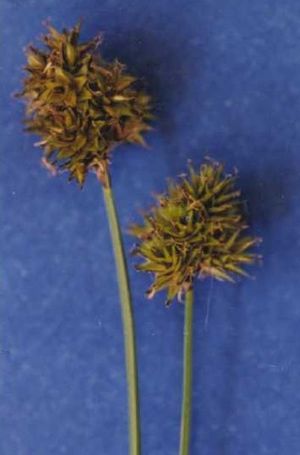Smallwing sedge facts for kids
Quick facts for kids Smallwing sedge |
|
|---|---|
 |
|
| Scientific classification | |
| Genus: |
Carex
|
| Species: |
microptera
|
| Synonyms | |
|
Carex festivella |
|
Carex microptera, also known as smallwing sedge, is a type of sedge plant. Sedges are grass-like plants that often grow in wet places. This plant is found naturally in western North America, which includes most of western Canada and the western United States.
You can often find smallwing sedge growing in damp mountain areas, such as wet meadows or along the banks of rivers. It grows in thick clumps with straight stems that can be anywhere from 20 centimeters (about 8 inches) to about one meter (about 3 feet) tall. The flowers grow in a tight bunch of green or brown spikes that are packed very closely together.
Contents
What is Smallwing Sedge?
Smallwing sedge is a plant that belongs to the Carex genus. This is a very large group of plants, with thousands of different species found all over the world. Sedges are often confused with grasses, but they have some key differences. For example, sedge stems are usually triangular and solid, while grass stems are often round and hollow.
Where Does it Grow?
Carex microptera is native to a large area in western North America. This means it has grown there naturally for a very long time. Its range stretches across many states in the western United States and provinces in western Canada.
Mountain Homes
This sedge loves places that are moist and often found in mountains. It thrives in environments like:
- Wet meadows: These are open areas in mountains where the ground stays wet.
- Riverbanks: The edges of rivers and streams provide the constant moisture it needs.
- Marshy areas: Sometimes it can be found in slightly boggy or swampy spots.
The plant is well-adapted to these cooler, wetter conditions often found at higher elevations.
What Does Smallwing Sedge Look Like?
Smallwing sedge is known for growing in dense groups, forming a clump of many stems. These stems stand upright and can reach different heights, from quite short to fairly tall.
Stems and Leaves
The stems of Carex microptera are usually green and strong. They grow close together, making the plant look bushy at its base. The leaves are long and narrow, similar to grass blades, and they also grow from the base of the plant.
Flowers and Seeds
The plant produces flowers that are grouped together in what is called an inflorescence. For smallwing sedge, this inflorescence is a tight cluster of small spikes. These spikes can be green or turn a brownish color as they mature. Because they are packed so closely, it can be hard to tell each individual spike apart. After flowering, the plant produces small seeds, which help it reproduce.
Life Cycle of a Sedge
Like many plants, Carex microptera goes through a life cycle that involves growing, flowering, and producing seeds.
How it Grows
Smallwing sedge is a perennial plant. This means it lives for more than two years. It can grow back each year from its roots, even after the leaves and stems die back in colder weather. This helps it survive harsh winters in its mountain habitat.
Reproduction
The plant reproduces by producing seeds. The flowers contain the parts needed for reproduction. Once pollinated, the flowers develop into small, seed-filled structures. These seeds can then fall to the ground or be carried by wind or water to new locations, allowing new smallwing sedge plants to grow.
Importance in Nature
Even though it might seem like just another grass-like plant, smallwing sedge plays an important role in its ecosystem.
Habitat and Food
Sedges, including Carex microptera, provide food and shelter for various animals. Many insects might feed on the plant, and birds or small mammals might eat its seeds. The dense clumps also offer cover for small creatures.
Soil Stability
Because it grows in dense clumps and often in moist areas like riverbanks, smallwing sedge helps to stabilize the soil. Its roots hold the soil in place, which can prevent erosion, especially during heavy rains or along fast-moving water. This is very important for maintaining healthy ecosystems in mountain environments.
See also
 In Spanish: Carex microptera para niños
In Spanish: Carex microptera para niños

